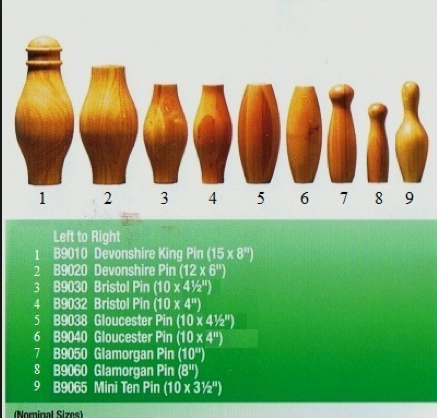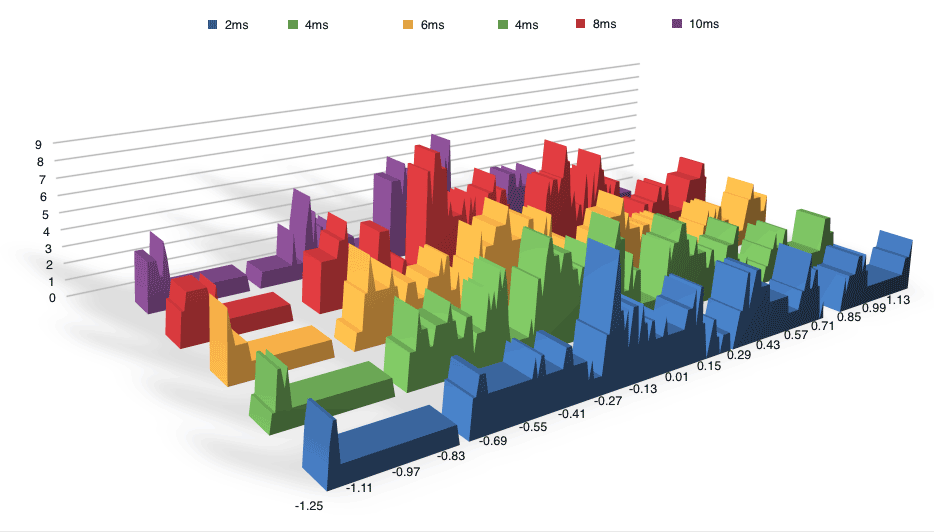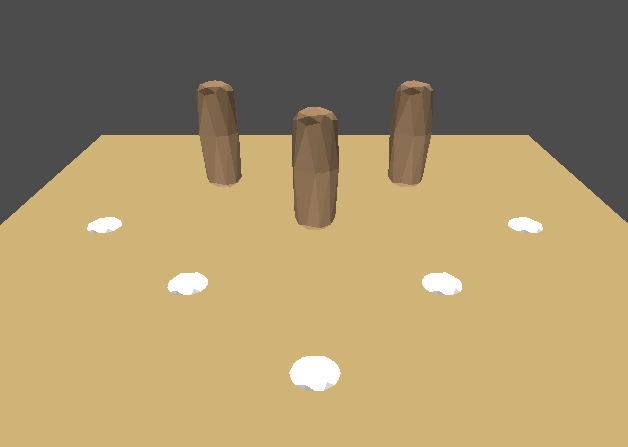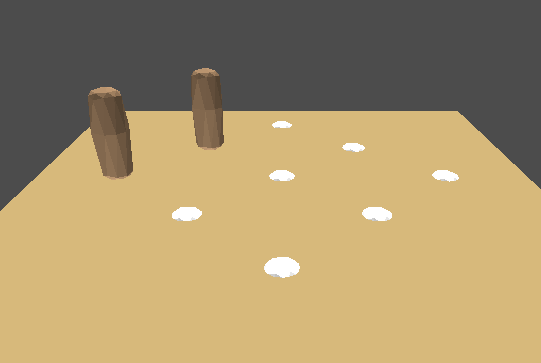Two years ago I created a 2D simulation of the game of pub skittles in an attempt to find the optimum strategies for playing. The simulation used parameters measured from our home alley. (We play in the Malmesbury skittles league at the Volunteer Inn, Great Sommerford.) Different alleys have different characteristics. For example different sized and shaped pins, different balls and different conditions of alley. I had some success with this simulation. It showed the effect of throwing the ball from different positions at different speeds towards different places amongst the pins. However it contained a number of hacks to account for the fact that the pins scatter in 3 dimensions. I decided to try and create a 3d simulation to get a better understanding of the game…
Assumptions and Model
The simulation is of the alley, ball and pins, not the player. The ball is “fired” from a point on the players line at a set speed and direction. There is no simulation of the random accuracy of the player. For example this excludes all effects from bad releasing of the ball from hand, not following through or keeping the eye on point where you want ball to go. The ball is always sent in exactly the direction the determined by the simulation.
No bounce or spin is assumed as both these effects seem to be negligible in the real game. Also the alley is assumed to be perfectly true and the balls without defects. In the real game all these things cause loss of accuracy but don’t change the underlying physics.
Measurements from the Volunteer Inn
| Property | Value |
|---|---|
| Length of alley | 8.9 metres |
| Separation between left and right pins | 1.225 metres |
| Separation between front and back pins | 1.225 metres |
| Pin height | 0.25 metres |
| Pin diameter | 0.115 metres |
| Pin weight | 1.1 Kg |
Pin shape  |
5 Gloucester Pin |
| Ball diameter | 0.125 metres |
| Ball weight | 1.4Kg |
| Restitution (what fraction of energy is preserved in collisions) http://hypertextbook.com/facts/2006/restitution.shtml | 0.8 |
| Friction http://www.roymech.co.uk/Useful_Tables/Tribology/co_of_frict.htm | 0.4 |
| Throwing speed (for a typical confident player) | 8 m/s |
Simulation Details
I implemented the simulation using JBullet, a Java port of the Bullet Physics library and used the demo application framework that is supplied with it to visualise the simulation in realtime. Results were output as comma separated values .csv files and imported into a spreadsheet to generate charts.
 Figure 1: Simulation UI
Figure 1: Simulation UI
Modelling the pin
The shape of the pin must have some effect on the game so accurate modelling is important. I approximated the Gloucester pin as a spheroid with top and bottom truncated. Although the rendering doesn’t show it, the actual physics model uses a much more detailed shape.
Scenarios
Test 1 - Better to throw straight down alley or from the side at an angle?
I ran four scenarios side by side:
The first always was to throw the ball parallel down the alley and the player stepped incrementally from left to right throwing the ball at a typical 8 meters per second.
In the second scenario the ball is always thrown from the centre. The ball is thrown scanning across incrementally from the left to the right of the alley.
For the third scenario the ball is thrown 66% of the way between the middle of the alley and the right-most pin. The ball is thrown scanning across incrementally from the left to the right of the alley.
In the fourth scenario the ball is thrown from the far right of the alley in line with the right most pin. This is actually impossible to do from the right of the alley at the Volunteer Inn due to a wall at the side of the alley. Though mirroring the scenario and throwing from the left would have the same result and be better for left handed players.
These charts show the number of knocked down pins on a fresh alley when the ball is aimed at a position along the line between the left most and right most pins where -1 is straight into the left most pin, 0 is straight into the middle pin (not the front pin) and 1 is straight into the rightmost pin.
 Chart 1: Distribution of knocked down pins when ball thrown straight down alley
Chart 1: Distribution of knocked down pins when ball thrown straight down alley
 Chart 2: Distribution of knocked down pins when ball thrown from centre
Chart 2: Distribution of knocked down pins when ball thrown from centre
 Chart 3: Distribution of knocked down pins when ball thrown from two thirds of way between centre of alley and right
Chart 3: Distribution of knocked down pins when ball thrown from two thirds of way between centre of alley and right
 Chart 4: Distribution of knocked down pins when ball thrown from far right of alley
Chart 4: Distribution of knocked down pins when ball thrown from far right of alley
The fractal nature of the distribution of knockdowns is interesting showing how subsequent pins are knocked down by both the ball and other pins depending upon the direction the the scatter.
| Play | Average roll down over 500 throws spread across alley |
|---|---|
| Straight down | 2.394 |
| From centre | 2.418 |
| From right 66% across | 2.370 |
| From far right | 2.394 |
Roughly the same number of pins where knocked down in total. So in that sense there is little in it. However the gap between front pin on one side can be completely eliminated by choosing where to throw from. It also raises some interesting peaks in the distribution that can be taken advantage of by an accurate player. So it appears that throwing from the side of the alley is optimal.
Test 2 - Where is the optimum aim for the first ball?
From scenario 1 (chart 4) it is clear that the optimum strategy is the throw from as far to the edge of the alley as you can get and aim for the far side of the front pin. There is a relatively large area where you can be assured of knocking down a minimum of 6 pins.
Looking in more detail… To be specific aim for just to the centre of the quarter-way point between the centre pin and the right.
 Figure 2 Optimum throw for strike on front pin (for 8 pins)
Figure 2 Optimum throw for strike on front pin (for 8 pins)
Test 3 - How hard to throw ball? In my experience the speed that the ball is thrown doesn’t have a big effect on pins knocked down. Obviously there must be enough energy in the ball to knockdown all the skittles that are touched but many players seem to trade off accuracy for speed. However another practical reason for not throwing too slow, which is outside this simulation, is when the alley is not true the effects are multiplied for a slow ball.
In this test I throw the ball from the far right at 2m/s intervals from 2m/s up to 10m/s sweeping across again from left to right.
| Speed | Average roll down over 250 throws spread across alley |
|---|---|
| 2 m/s | 1.752 |
| 4 m/s | 2.140 |
| 6 m/s | 2.136 |
| 8 m/s | 2.416 |
| 10 m/s | 1.544 |
It is definitely the case that 2m/s is too slow and many pins didn’t fall down because they just didn’t get knocked hard enough. Throwing faster at 8m/s seemed optimal over slightly slower speeds. I am uncertain about the 10m/s speed as this was starting to introduce artefacts from the simulation. Sometimes the ball appear to shoot straight past a pin that would over wise have been hit at a lower speed. Obviously that is impossible in real-life.
 Chart 5: Distribution of roll downs across the alley at varying speeds when thrown from far right
Chart 5: Distribution of roll downs across the alley at varying speeds when thrown from far right
Test 4 - 3 Pins remaining
There is a a common arrangement of 3 pins that should be possible to knock down with one ball to maximise the chances of a “spare” (when all pins are knocked down with a ball remaining.)
 Figure 3: A common 3 pin arrangement
Figure 3: A common 3 pin arrangement
Running this through the simulation with the ball thrown from the far right of the alley we get the following distribution:
 Chart 6: Distribution of roll downs for the 3 pin scenario
Chart 6: Distribution of roll downs for the 3 pin scenario
This gives us the following probabilities:
| Aim | 3 pins | 2 pins | 1 pins |
|---|---|---|---|
| Ball strikes far side of centre pin | 44% | 31% | 25% |
| Ball strikes near side of centre pin | 50% | 6% | 44% |
So striking the far side is the safer option but with a slightly lower probability of getting all 3.
Test 5 - 2 Pins remaining
Another common arrangement is to have 2 pins remaining with one just behind the other.
 Figure 4: A common 2 pin arrangement
Figure 4: A common 2 pin arrangement
Running this through the simulation with the ball thrown from the far right of the alley we get the following distribution:
 Chart 7: Distribution of roll downs for the 2 pin scenario, ball thrown from right of alley
Chart 7: Distribution of roll downs for the 2 pin scenario, ball thrown from right of alley
Running this through the simulation with the ball thrown from the far left of the alley we get the following distribution:
 Chart 8: Distribution of roll downs for the 2 pin scenario, ball thrown from left of alley
Chart 8: Distribution of roll downs for the 2 pin scenario, ball thrown from left of alley
| Aim | probability of 2s | probability of 1s |
|---|---|---|
| From right, ball strikes left side of front pin | 68% | 32% |
| From right, ball strikes right side of front pin | 0% | 100% |
| From left, ball strikes left side of front pin | 44% | 56% |
| From right, ball strikes right side of front pin | 56% | 44% |
So the best strategy for getting both pins is to throw with as much angle as possible, i.e. to the far side and to aim for the far side of the front pin.
Conclusion
The fractal nature of the knockdowns shows that there are optimal strategies available. These will always be dependent upon a fair degree of accuracy of the play - some of the sweet spots are quite small.
It appears that a once the ball reaches a reasonable momentum it doesn’t make a big difference how hard it is thrown on a true alley. However position of the player and their aim are more important. Whilst the position is unimportant statistically if the ball is thrown randomly towards the pins the distribution becomes more skewed as the player moves to the outside of the alley. This creates higher and larger peaks of roll downs - i.e. increases the risks and gains. When throwing from the far outside of the alley the optimum position appears to be to strike the centre pin on the far side. This is the only region where an 8 roll down is possible and the width of this region is reasonable. However aim to far too miss the front and the roll down rapidly drops to a large plateau of 1 pin!
The best knockdown achieved in the simulation was 8 pins - not a flopper. I’m not sure if this is because floppers require some kind of fluke situation or if there is something off in the simulation.
So once you’ve rolled down 6,7,8 with your first ball tests 4 and 5 give you the optimum strategy for a spare. If you have three pins remaining the best strategy is to go for a spare and aim again for the near side of the remaining front pin. A lower risk strategy is to go for the far side with only a 25% change of hitting one pin assuming you can at least hit one.
When just 2 pins remain in a diagonal the optimum strategy is to go for a glancing hit to the far side of the remaining front pin from as far to the side as possible.
The limitations of the simulation where obvious at 10m/s throwing speed. I tried to find workarounds but in the time available none were found.
Should future funding become available this work could be taken further possibly including testing predictions with a skittleing robot on a real alley.